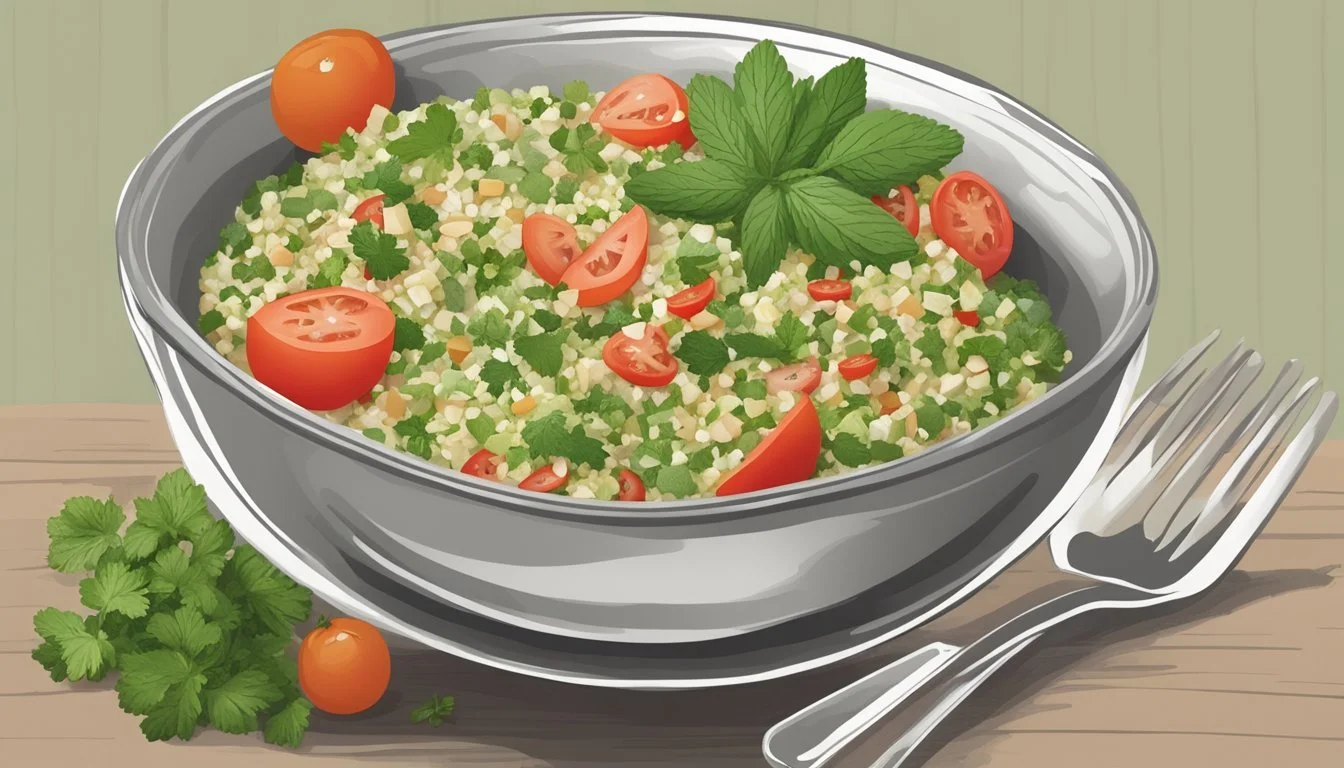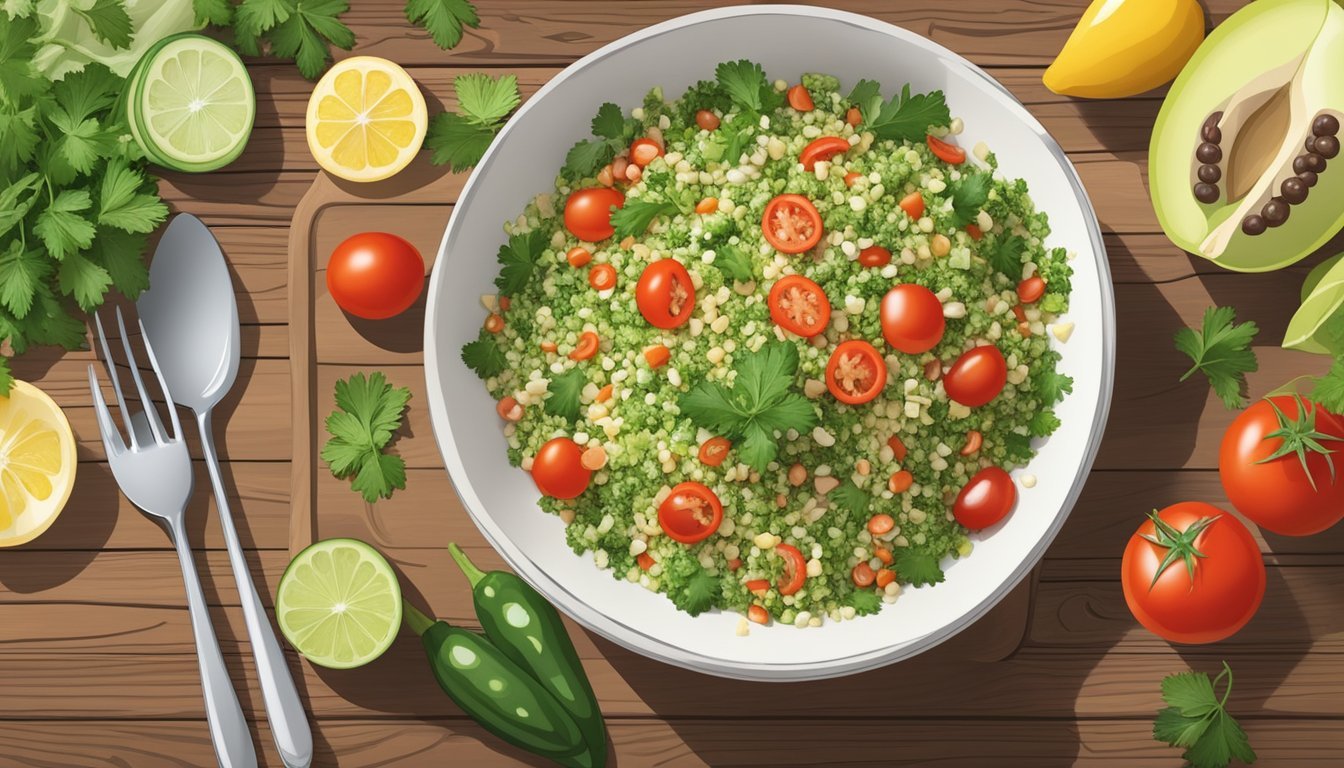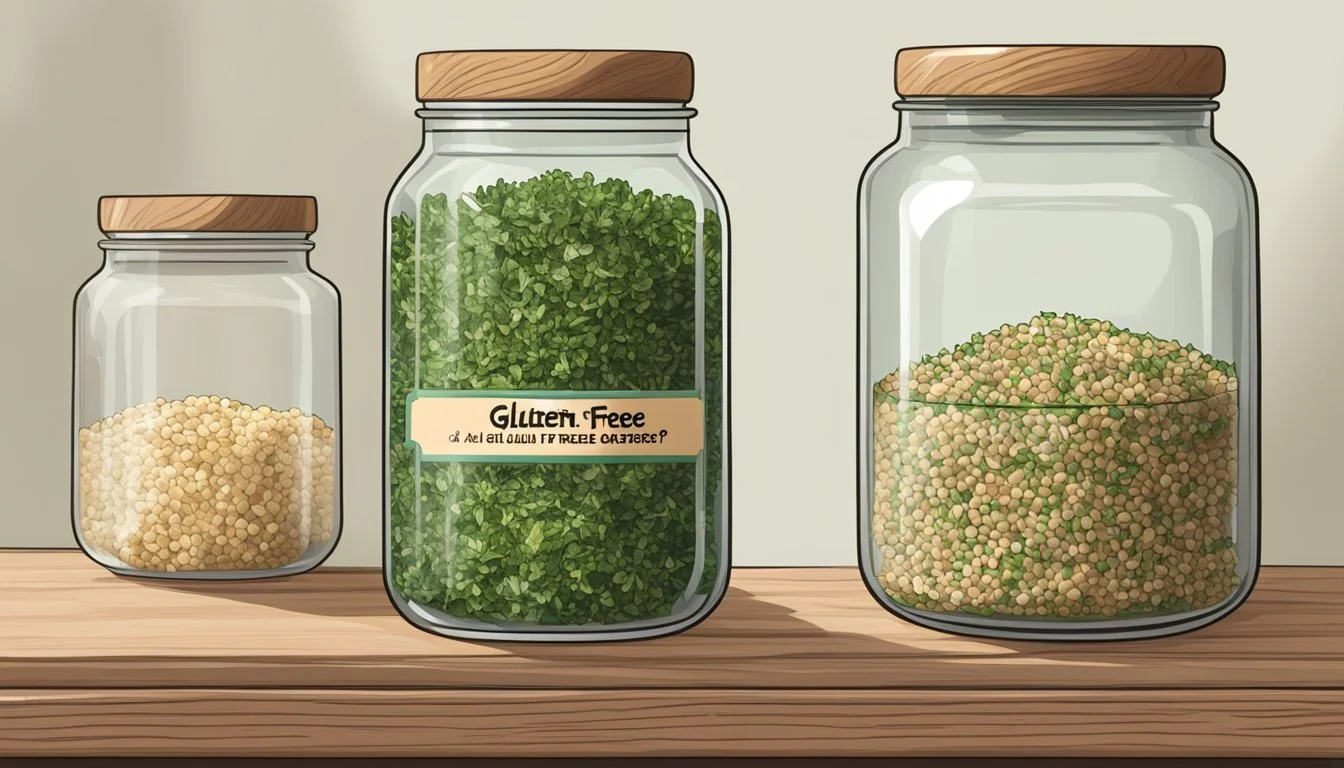Is Tabouleh Gluten-Free?
Understanding the Ingredients and Alternatives
Tabbouleh is a Mediterranean dish known for its vibrant flavors and healthful ingredients, traditionally made with bulgur wheat, fresh herbs, tomatoes, and a lemony dressing. While the classic recipe includes gluten-containing bulgur, the increasing demand for gluten-free options has led to a rise in alternative recipes that are suitable for those with gluten sensitivity or celiac disease. These adaptations often employ gluten-free grains such as quinoa, buckwheat, or millet.
Navigating a gluten-free diet requires careful attention to ingredients, particularly in dishes like tabbouleh where wheat is a primary component. However, the simplicity of tabbouleh's composition makes it exceptionally adaptable for a gluten-free version without sacrificing taste or texture. Opting for gluten-free grains not only ensures that the dish is safe for individuals avoiding gluten, but it can also introduce a new dimension of flavor and nutritional value.
When preparing a gluten-free tabbouleh, it is crucial to ensure all ingredients, including any additions like spices or flavors, do not contain gluten. As with any dietary consideration, reading labels and being aware of cross-contamination risks are paramount to maintaining a gluten-free diet while enjoying this refreshing, herbaceous salad.
What is Tabbouleh?
Tabbouleh is a Levantine salad known for its fresh and herbaceous flavors, commonly served as part of a mezze, or as a stand-alone dish. It's a staple in Middle Eastern cuisine, celebrated for both its taste and nutritious profile.
Origins and Cultural Significance
Tabbouleh has its roots in the mountainous regions of Lebanon and Syria. Its cultural significance lies in its use of local, fresh ingredients, representing a quintessential part of the Middle Eastern culinary heritage. This dish reflects the importance of agriculture and seasonal produce in the regions, with parsley being a central feature.
Traditional Ingredients
Tabbouleh typically consists of several key components:
Parsley: This leafy green herb is not just a garnish but the star of the dish, finely chopped and abundant.
Mint: Another herb for a refreshing note.
Bulgur: This is a type of dried cracked wheat; a staple grain in the Middle Eastern pantry.
Tomatoes: They add a juiciness and sweetness to the salad.
Olive oil and Lemon Juice: These provide the zesty dressing that brings all the ingredients together.
Each of these ingredients is carefully chopped and combined to create a salad that is both flavorful and texturally complex. The use of bulgur wheat is what often raises the question of whether tabbouleh is gluten-free; traditional tabbouleh is not gluten-free due to the presence of bulgur. However, various gluten-free grains or even finely chopped vegetables like cauliflower can be used as substitutes to cater to a gluten-free diet.
Understanding Gluten
In assessing whether tabouleh is gluten-free, one must first understand what gluten is and its presence in various foods. Gluten is a protein composite that poses dietary challenges for certain individuals.
What Contains Gluten?
Gluten is predominantly found in grains such as wheat, barley, and rye. Common food items containing these grains include bread, pasta, cereals, and many processed foods. Specifically, bulgur wheat, a key ingredient traditionally used in tabouleh, contains gluten.
Common Sources of Gluten:
Wheat (including bulgur, semolina, spelt, farro)
Barley
Rye
Gluten Intolerance and Sensitivity
People with celiac disease, non-celiac gluten sensitivity, or wheat allergy need a strictly gluten-free diet for health reasons. Ingesting gluten can lead to serious health implications for these individuals, including digestive issues, nutrient deficiencies, and increased risk for certain types of intestinal damage.
Health Reactions to Gluten:
Celiac Disease: An autoimmune disorder where gluten ingestion damages the small intestine.
Non-Celiac Gluten Sensitivity: Gluten consumption causes symptoms similar to celiac disease without the intestinal damage.
Wheat Allergy: An allergic reaction to wheat proteins, which can include gluten.
A gluten-free diet requires meticulous label reading and awareness of ingredients, food processing, and cross-contamination risks to maintain one's health.
Tabbouleh and Gluten
In addressing the gluten content in tabbouleh, it is important to consider the traditional ingredients used and their gluten status, as well as the alternatives that cater to a gluten-free diet.
Is Traditional Tabbouleh Gluten-Free?
Traditional tabbouleh is not gluten-free as it typically contains bulgur, a wheat product that includes gluten. Bulgur is a staple grain in tabbouleh that lends the dish its characteristic texture and nutty flavor. Individuals with celiac disease or gluten sensitivity should avoid traditional tabbouleh due to the presence of bulgur.
Gluten-Free Alternatives for Tabbouleh
To make tabbouleh gluten-free, substitutes for bulgur are available, prominent among which are quinoa and millet. These gluten-free grains emulate the texture of bulgur while providing a similar nutritional profile.
Quinoa: A versatile and nutritious seed, quinoa is a popular alternative for a gluten-free tabbouleh. It is an excellent source of protein and is cooked using a water-to-grain ratio of approximately 2:1.
Millet: Another suitable replacement, millet is cooked much like rice and offers a fluffy texture to the salad.
Replacing bulgur with these gluten-free options can make tabbouleh safe and enjoyable for those following a strict gluten-free diet.
Preparing Gluten-Free Tabbouleh
Creating a gluten-free tabbouleh requires careful selection of gluten-free grains and fresh ingredients. The following guide provides specific steps and ingredients for a delicious and safe tabbouleh for those avoiding gluten.
Selecting the Right Ingredients
To ensure the tabbouleh is gluten-free, one must choose a suitable substitute for traditional bulgur wheat. Quinoa or millet serve as excellent gluten-free alternatives, providing similar textures and absorbing flavors well. Freshness in ingredients like parsley, mint, tomato, and cucumber is crucial to achieving the vibrant taste tabbouleh is known for. The salad's dressing is simple yet pivotal, consisting mainly of high-quality olive oil and fresh lemon juice, with salt and pepper for seasoning.
Step-by-Step Recipe Guide
Cook the Grain: Start by bringing 1 cup of water to a boil in a medium saucepan. Add ½ cup of rinsed quinoa or millet with a pinch of salt, cover, and simmer for about 15-20 minutes or until the water is absorbed. Remove from heat and let it sit covered for 10 minutes. Fluff with a fork and allow it to cool.
Prep the Ingredients: While the grain is cooking, finely chop the fresh parsley and fresh mint. Dice the tomato and cucumber, and thinly slice the green onion.
Compose the Salad: In a large bowl, combine the cooled grain with the chopped parsley, mint, tomato, cucumber, and green onion. Drizzle with olive oil and generous squeezes of lemon juice. Season with salt and pepper to taste.
Toss and Serve: Stir the mixture gently to ensure even distribution of dressing and seasonings. Taste and adjust the levels of lemon juice, olive oil, and seasoning if necessary. Serve the salad fresh or allow it to sit for a few hours in the refrigerator to let the flavors meld.
Nutritional Benefits
Tabbouleh salad offers a variety of nutritional advantages, stemming from its wholesome ingredients which are rich in essential nutrients like vitamins, minerals, and fiber.
Health Benefits of Tabbouleh
Tabbouleh is considered healthy due to its high content of vitamins and minerals, and its potential to support a balanced diet. Ingredients commonly found in tabbouleh such as parsley are rich sources of Vitamin C, Vitamin K, and Iron. The olive oil in the salad delivers a dose of monounsaturated fats, which are known to be heart-healthy. Its components collectively contribute to an array of health benefits, including improving digestion due to the high fiber content, and contributing to heart and bone health.
Parsley: High in Vitamin C and Iron
Olive Oil: Rich in monounsaturated fats
Macronutrients and Vitamins
Tabbouleh is typically low in calories and fat while providing a modest amount of plant-based protein, making it a suitable dish for those seeking a nutrient-dense meal. The gluten-free variations of tabbouleh often include grains like quinoa or buckwheat, which offer a complete protein profile along with fiber and magnesium. Olive oil not only enhances flavor but also contributes Vitamin E and healthy fats. An analysis of macro and micronutrient contents reveals the balance of nutrition found in this dish.
Protein Fat Fiber Vitamins Iron Magnesium Quinoa High Low High B-Vitamins High High Olive Oil Low High None Vitamin E None None
In gluten-free versions, the choice of grain as a base (for example, quinoa or millet) plays a significant role in the overall nutrient composition, ensuring that the dish remains high in essential nutrients.
Serving and Pairing Suggestions
Tabbouleh salad is a versatile dish that pairs well with a variety of Middle Eastern dishes and can be presented beautifully with a few simple tips.
Complementary Dishes
Tabbouleh, traditionally a Lebanese side dish, is often served as part of a mezze platter. It pairs excellently with:
Falafel: These deep-fried chickpea balls are a classic choice.
Hummus: A creamy dip made from pureed chickpeas and tahini.
Stuffed Grape Leaves: Often filled with rice and herbs.
Grilled Vegetables: (What wine goes well with grilled vegetables?) Enhances the meal for vegetarians and vegans alike.
Kebabs: Grilled meat skewers for a hearty addition.
Serving and Presentation Tips
Presentation is key; serving tabbouleh salad in a large, shallow serving bowl can showcase the vibrant colors and make it inviting. Use these tips for serving:
Chill the Salad: It's best served cold.
Garnish: Top with additional parsley or mint leaves for a fresh look.
Lemon Wedges: On the side for guests to add an extra zest if desired.
Always be mindful to keep the cuisine authentic and the taste complementary when pairing tabbouleh with other dishes.
Preservation and Storage
Proper storage methods ensure the freshness and extend the shelf life of tabbouleh. It's crucial to consider both the preservation of leftover tabbouleh as well as maintaining the freshness of the individual ingredients involved.
Storing Leftover Tabbouleh
For leftovers, an airtight container is essential to preserve the quality of tabbouleh. Storing the salad in the refrigerator prolongs its life, typically allowing it to stay fresh for 5-7 days. It's important to ensure that the container is sealed properly to prevent the tabbouleh from absorbing other odors and tastes from the fridge.
Keeping Ingredients Fresh
Fresh ingredients like veggies and herbs are the backbone of a vibrant tabbouleh. To keep fresh veggies crisp, one should store them in the crisper drawer of the refrigerator; this is especially true for cucumbers and tomatoes, if used, to prevent them from becoming soggy. Fresh herbs, such as parsley and mint, should be wrapped in a damp paper towel and placed in a plastic bag before refrigerating to maintain their moisture without becoming waterlogged. When considering the addition of lemon zest, one should zest the lemon prior to use to ensure peak freshness and vibrant citrus notes.
Frequently Asked Questions
In this section, readers can find clear answers to some of the most common questions surrounding the preparation of gluten-free tabbouleh, along with practical tips to ensure a delicious outcome.
Common Queries About Tabbouleh and Gluten
Is traditional tabbouleh gluten-free?
No, traditional tabbouleh is not gluten-free because it typically contains bulgur, which is a wheat product that contains gluten.
Can tabbouleh be made gluten-free?
Yes, tabbouleh can be made gluten-free by substituting bulgur with gluten-free grains such as quinoa, buckwheat, or finely chopped walnuts.
Gluten-Free Grains Suitable for Tabbouleh Quinoa Yes Buckwheat Yes Finely Chopped Nuts Yes
Tips for Making Gluten-Free Tabbouleh
Choosing Ingredients: Select fresh parsley, mint, and ripe tomatoes to provide the classic tabbouleh flavors. Use fresh lemon juice and extra virgin olive oil for dressing to add brightness and richness to the salad.
Preparation Tips:
Rinse gluten-free grains thoroughly before cooking to remove any excess starches or powders.
Cook grains just until tender, then allow them to cool completely before incorporating them into the salad. This prevents the salad from becoming mushy.
Finely chop the herbs and vegetables to achieve the signature texture of tabbouleh.
Season carefully, as the grains will absorb the flavors of the lemon juice, olive oil, and spices.
Gluten-Free Grains Cooking Time:
Quinoa: Cook for about 15 minutes then let it rest off the heat.
Buckwheat: Usually cooks in 15 minutes, allow to sit for an additional 10 minutes covered before fluffing.
With these insights, anyone can craft a delicious, gluten-free tabbouleh that remains true to the dish's bright, herby profile while adhering to dietary restrictions.







